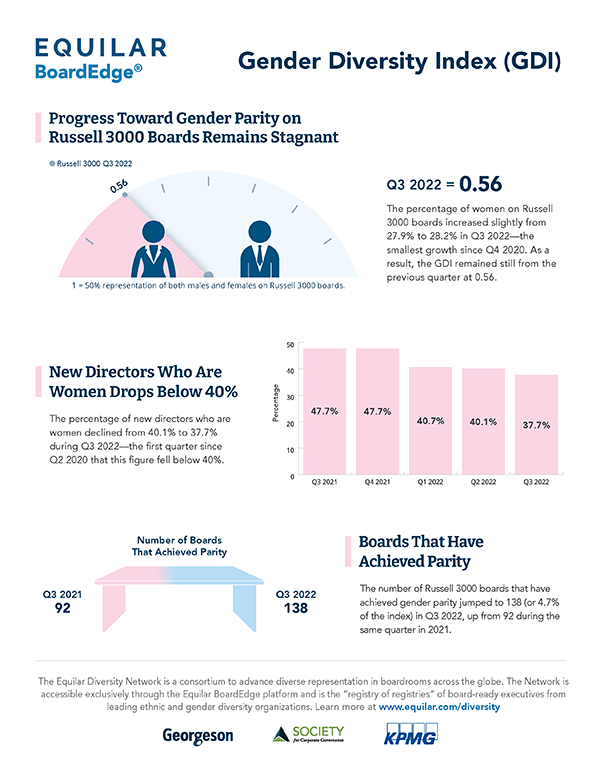Q3 2022 Gender Diversity Index
Prevalence of New Women Directors Falls Below 40% for the First Time in Two Years
December 5, 2022
Amit Batish
The percentage of women on Russell 3000 boards increased slightly from 27.9% to 28.2% during the third quarter of 2022. As a result, the Q3 2022 Equilar Gender Diversity Index (GDI)—featured in a recent CNBC Fast Money segment—remained stagnant at 0.56, where 1.0 represents an equal number of men and women on Russell 3000 boards.

Over the last decade, companies have come under mounting pressure to diversify their boardrooms and bring fresh perspectives to the table. Since 2016, Russell 3000 boards have made significant progress toward gender diversity, as the prevalence of women directors has almost doubled from 15.1%. Nevertheless, momentum toward gender parity on boards has slightly slowed in recent quarters.
The percentage of new directors who are women increased steadily almost each quarter since Equilar launched the GDI. However, during Q3 2022, 37.7% of new Russell 3000 board members were women—down from 40.1% in the previous quarter. In fact, Q3 2022 was the first quarter since Q2 2020 that this figure dipped below 40% and was just the third quarter since Q3 2018 to not achieve that threshold. While gender diversity on boards remains a strong area of focus among key stakeholders, companies have also placed an emphasis on other forms of diversity—such as ethnicity, skill and sexuality—which may be leading to the slowdown in progress of new women directors, as well as other minority groups.

“Women of color in particular are deeply underrepresented in corporate boardrooms, and board gender diversity overall still has a long way to go before reaching a level consistent with the population as a whole,” said Susan Angele, Senior Advisor, Board Governance at KPMG’s Board Leadership Center. “The efforts that have been made since 2020 to increase racial and ethnic diversity on boards have shown some progress, though Black, Latino and Asian directors of both genders continue to be woefully underrepresented. As boards recruit, it is important to avoid a zero-sum mentality toward diversity.”
The path toward gender diversity on boards was dealt a blow earlier in 2022. In May, California’s SB 826 was overturned and deemed unconstitutional by Los Angeles Supreme Court Judge Maureen Duffy-Lewis, with the reasoning that the legislation affected men and women in an unequal manner. This piece of legislation required public corporations in California to have at least one woman on their boards. Meanwhile, a California judge also recently overturned AB 979, which required boards to include a minimum number of directors from underrepresented communities.
“In countries like the UK, Australia and Canada, where they’ve asked for diversity disclosure, it has had an impact,” said Jennifer Reynolds, CEO at the Women’s Corporate Directors Foundation, in a recent C-Suite magazine interview. “There was a setback in terms of what we saw in California, and I worry that there is a tone that’s being set, generally, that we don’t have to care about this anymore.”
Nevertheless, despite the setbacks, the prevalence of women on Russell 3000 boards is at its highest point since Equilar began tracking the GDI, and the momentum, though slower than past years, is likely to continue. Proxy advisory firms and investors will play an ongoing role in the push for greater diversity on boards in the coming year. “2023 is a key implementation year for many diversity-related director voting policies at proxy advisory firms and major institutional investors, which will likely drive the number of boards with zero women down further,” said Brigid Rosati, Director of Business Development at Georgeson. “Glass Lewis has recommended against the nominating committee chair at companies where boards are under 30% gender diverse. State Street Global Advisors and BlackRock have coalesced around a 30% diversity expectation at many companies and may vote against directors where a perceived or visible lack of diversity is present.”
Additionally, during Q3 2022, the number of Russell 3000 boards that have achieved gender parity jumped to 138 (or 4.7% of the index), up from 92 during the same quarter in 2021. Meanwhile, the percentage of boards with no women has dropped from 3.2% to 2.1% over the last year, another sign of progress. Historically, a key factor driving more diversity on boards has been the prevalence of board diversity-related shareholder proposals. “Many companies have made meaningful strides in diversifying their boards and institutional investors have increasingly revised proxy voting guidelines to provide for votes against directors where companies fall short of their diversity expectations,” explained Rosati.
With investors across Corporate America playing a pivotal role in the push for board diversity, experts argue that now is an opportune time for executive women to seek their first board seat.
“Boards have become more sophisticated about their skill set needs, and they are increasingly willing to recruit outside their immediate networks and to consider first-time board members, including those who have not come from the C-suite,” said Angele. Angele offers a few suggestions for women seeking their first board seat:
Carefully define your value proposition and your interests, to increase the chance of finding the right fit.
Make yourself visible as a prospective board member, as networking continues to be a critical component of the board search process.
Keep at it. Some executives land board seats quickly, but it is not unusual for highly successful and respected board members to have spent up to three years in their first board search.
As we enter 2023, it’s certainly worth keeping an eye on how the GDI tracks to close out 2022 and kickoff the new year. With diversity consuming a large portion of ESG topics across Corporate America, companies must remain astute to avoid any pitfalls and backlash from investors for falling behind the curve. Addressing any lack of diversity will prove to be paramount in 2023.
About Equilar Gender Diversity Index
The Equilar GDI reflects changes on Russell 3000 boards on a quarterly basis as cited in 8-K filings to the SEC. Most indices that track information about board diversity do so annually or even less frequently, and typically with a smaller sample size, sometimes looking back more than a full year by the time the information is published. While this data is reliable and accurate, the Equilar GDI aims to capture the influence of the increasing calls for diversity from investors and other stakeholders in real time.
The Equilar GDI is powered by Equilar BoardEdge, a database of more than one million public company board members and executives. BoardEdge includes exclusive features that show how board members and companies are connected to each other, as well as the Equilar Diversity Network (EDN), a “registry of registries” of board-ready executives from leading ethnic and gender diversity partnerships, organizations, and publications.
Contact

Amit Batish
Director of Content at Equilar
Amit Batish, Director of Content at Equilar, authored this post. Researchers Edbert Jao, Seth Mutenda, Evin Peterson, Forrest Rouleau, Leo Rubenstein, Kelly Stangl and Lexie Tang contributed data and analysis. Please contact Amit Batish at abatish@equilar.com for more information about this article.
 Solutions
Solutions













